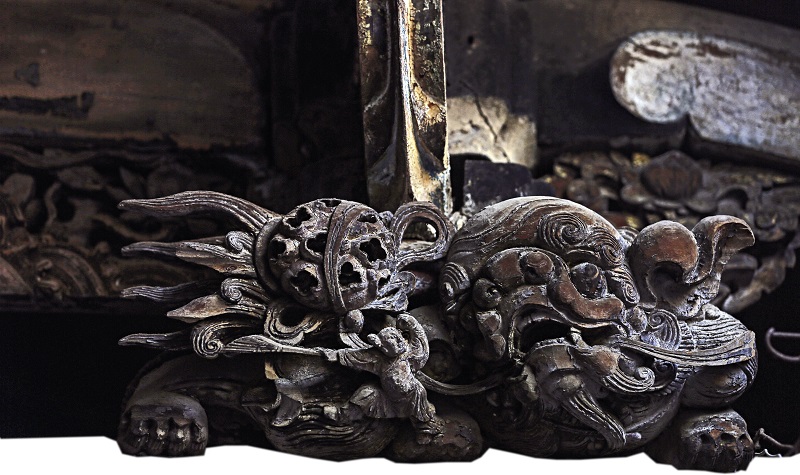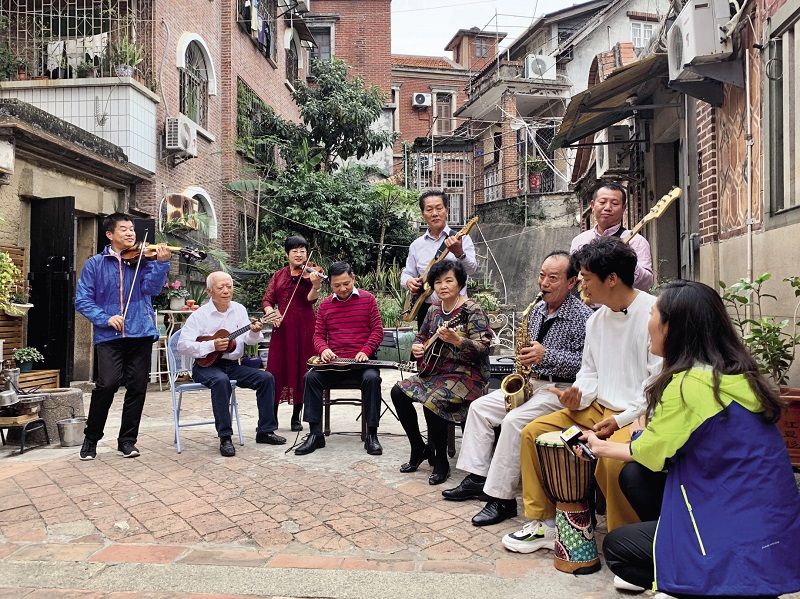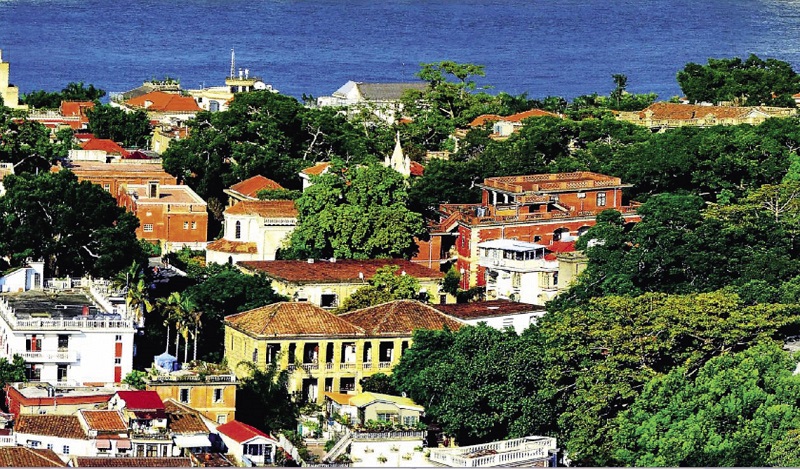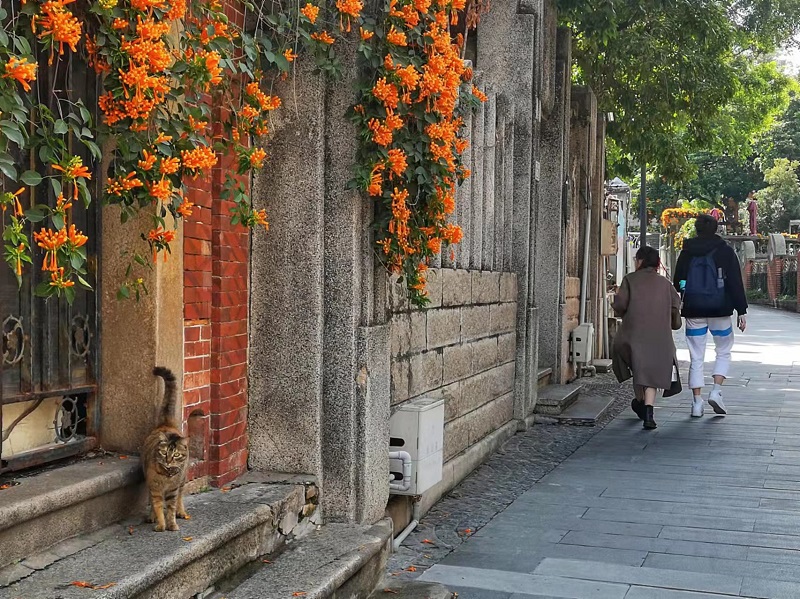
Beautiful wood carvings preserved in Lei Cuo.
“I bet my great-great-grandfather Lei Zhengzhong would never have imagined that over a hundred years later, the house he built with his own hands would be revitalized by my generation,” said Lei Jingjing excitedly about the ongoing repairs of Lei Cuo, one of the few traditional Chinese-style buildings on Gulangyu (or Kulangsu) Island, a world heritage site in the city of Xiamen. Lei is the fifth-generation owner of Lei cuo. In June, the 125-year-old house will be unveiled after completing renovations.

The music band Lei Jingjing’s parents formed called Lei Cuo in the neighborhood is performing.
Rebirth of Lei Cuo
Cuo means “house” or a traditional architecture in Minnan (southern Fujian Province). In 1897, Lei Zhengzhong, the first Chinese doctor of Western medicine in Gulangyu, built a red-brick two-courtyard house on the island and named it Lei Cuo, after his family name.
“Lei Cuo is one of the few well-preserved Minnan-style buildings on the island that are still inhabited by descendants of the original family who built them,” said Cai Songrong, director of the Gulangyu World Cultural Heritage Monitoring Center. According to Cai, Lei Cuo holds high cultural value in the historical international settlement. In November last year, when the bearing structure of the house needed repairing, a local committee in charge of house protection immediately formulated a plan. Lei was the one held responsible for this repair on the residents’ side.
“The primary principle is to restore it to look like it did in the past. The beams and purlins damaged by termites were replaced with new similar ones, and the ridge of the house was also repaired. I did a lot of research into the history of the house and provided the design and construction company with much information,” explained Lei. In her eyes, the renovation is not only to preserve a house for her family, but also to protect the living history of the indigenous people in Gulangyu over the past century.
When the renovation was about to come to an end, Lei and her family members had a meeting during which they decided to build a family museum in one of the rooms. “Old photos of our ancestors and family stories will be displayed for more people to learn about the history behind this house,” she said. For this reason, Lei closed her bed and breakfast (B&B) inn temporarily in order to fully concentrate on studying the history of her ancestral house. “This is the largest-scale renovation Lei Cuo has undergone since it was built,” said Lei. To her, it served as an incredible opportunity to sort out the century-old history of her ancestral house.
After reading a large number of historical materials about Gulangyu, she came to a clear understanding of her ancestral house during the past century. “Lei Wenquan, the grandson of my great-great-grandfather, graduated from the University of Edinburgh with a diploma in civil engineering. After returning home, he served as the chief architect of the Burma Road bridges. His brother Lei Wenkeng was CEO of the Texaco Oil Company, representing four countries. Another brother, Lei Wending, my grandpa, was an architect. The first airport in Xiamen and the library of Xiamen University were all his masterpieces,” said Lei. Thanks to the careful maintenance over the past century, the house was passed down intact to her generation.
In 2009, Lei’s parents formed a music band, also called Lei Cuo, with neighbors, relatives, and friends as members, in an effort to carry forward the living culture of the ancestral house. The band unexpectedly contributed a bit when the historical international settlement of Gulangyu was applying to be a UNESCO world heritage site.
During the application, over 20 experts from the International Scientific Committee on Shared Built Heritage of the International Council on Monuments and Sites (ICOMOS), including Dr. Siegfried RCT Enders, hailed the band’s performance as an awesome living element of the island. In 2017, when Irina Bokova, director-general of UNESCO, was awarding Gulangyu the world heritage certificate, the band played the famous Italian song Isle of Capri, which enthralled Bokova so much that she danced to it.
This time, during the renovation, Lei carved her name on one of the colored tiles she selected, and pasted it onto the eaves. She said that years later, this would become history to be told to future generations. “It’s just like the history of my forefathers is now under my fingertips. Without the inheritance of generation after generation, our ancestral house couldn’t have been preserved as well as it is today.”
“When I was a child, I would often look up at the exquisite wood carvings on the house. The carved flowers, birds, fish, and insects are so lifelike that their details remain vivid in my memory till today,” said Lei. She added that even after a century, the family motto on the gate – “When dealing with external affairs, be a gentleman; with family affairs, be honest and kind” – still resonates with them to this day.

A glimpse of the beautiful Gulangyu islet, a world cultural heritage site.
Old Houses Renovated
Unlike Lei, a native Gulangyuer, 43-year-old Lin Conghai likes to call himself a newcomer.
“I came to this island in 2007 and opened my first B&B in an old house. Now I own three of them. I like to call them ‘family inns,’ as I hope to give tourists a sense of home from the moment they check in,” said Lin.
As one of the earliest to open a B&B on the island, Lin witnessed the transformation of Gulangyu. In the past, according to him, several old houses fell down due to disrepair, but after 2005, when the Xiamen municipal government stepped in, there was increased protection of old houses, and private capital was also encouraged to invest there. “That’s when old houses on the island began to rise to prominence,” Lin said.
In addition to managing his own ventures, Lin also acted as chairman of the B&B Association in Gulangyu, and accordingly has given more thought to the development of the hundreds of B&Bs on the island. “Their styles vary and their owners have different visions for their development. While restoring the old buildings, we also need to retain the overall atmosphere of the historical settlement,” he said. Lin noted that there are now over 1,000 old buildings on the island, half of which have been repurposed into B&B facilities. In this way, the community is functional and gets revived through tourism. “This is the optimum solution for cultural heritage protection,” he said.
Another B&B business owner, Zhang Xiaojuan, shared similar thoughts. This year is the 10th year since she began operating a B&B on the island. The old house she managed was built in 1883, once a sanatorium for European and American seamen and later the location of the Tait & Co. merchant house. In 1909, Belgium established its consulate in Xiamen, and the second Belgian consul selected this house as his official residence.
“After careful renovation and nearly 10 years of maintenance, the old house now gives people a strong sense of history. It is no longer a dusty, cold building, but a home with memories, a continuation of life,” said Zhang. She said that every time when guests arrived, she would tell them the story of the house. Her B&B has become popular on the island as a result of its integration of history and modern amenities.

The streets of Gulangyu come to life with colorful flowers during the spring time.
Linking the Past and the Present
“If old buildings are the soul of Gulangyu, then the stories behind them are a rhythm. There are 151 immovable cultural relics and 439 historic buildings now. We should not only protect them, but also ‘activate’ them,” said Cai Songrong.
Wu Xiaowen is a professor at the School of Architecture and Civil Engineering of Xiamen University and director of the Cultural Heritage Research Institute at the Architectural Design and Research Institute Co., Ltd. of the university. She has been fond of the unique cultural and community atmosphere of Gulangyu since childhood and has paid great attention to the preservation of the cultural heritage there.
“The participation of local residents is indispensable to the preservation of Gulangyu’s heritage,” Wu said. One key aspect of the Gulangyu world heritage is the local community. The heritage came into being in modern times as the island bears witness to the spread of foreign culture, and the wisdom of overseas Chinese as well as local craftsmen.
“It is a living heritage site. It is functional not only as a community just as it was built, but also culturally,” Wu said. She believes people must be actively involved in its protection. “Now both the native and the new residents are passionate about heritage protection,” she said.
Wu and Lei are close friends. Lei had asked her for advice before the renovation of Lei Cuo began. “Respect history, facts, and the original style of the house” was her reply.
Thus far, Gulangyu has made many attempts in local heritage protection, and is quite successful in incorporating commerce and dissemination of the local culture into it. “In recent years, I’m glad to see that Gulangyu has been developing toward sustainable heritage tourism,” said Wu. “In the future, I hope the culture will be as diverse as it is today, connecting the present and the past to present the world a more vivid and real-world cultural heritage.”